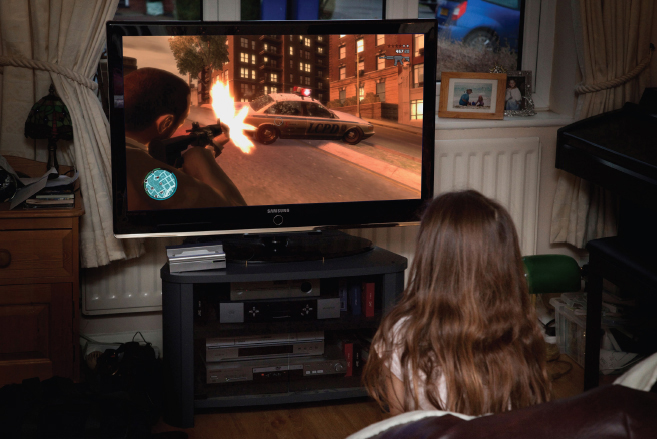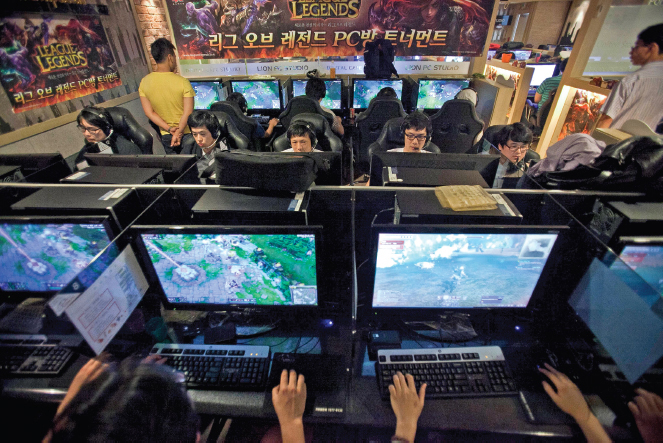Trends and Issues in Digital Gaming
The ever-
Electronic Gaming and Media Culture
LaunchPad

Video Games at the Movies
Alice, the hero of the Resident Evil film series, fights zombies in this clip.
Discussion: In what ways does this clip replicate the experience of game play? In what ways is a film inherently different from a game?
Beyond the immediate industry, electronic games have had a pronounced effect on media culture. For example, fantasy league sports have spawned a number of draft specials on ESPN as well as a regular podcast, Fantasy Focus, on ESPN Radio. Fantasy football has even inspired an adult comedy called The League on the cable channel FXX. In the case of the Web site Twitch, streaming and archived video of digital games being played is the content. In just three years, the site became so popular that Amazon bought it for almost $1 billion to add to its collection of original video programming.
Like television shows, books, and comics before them, electronic games have inspired movies, such as Lara Croft: Tomb Raider (2001), the Resident Evil series (2001–
Books and electronic games have also had a long history of influencing each other. Japanese manga and anime (comic books and animation) have also inspired video games, such as Akira, Astro Boy, and Naruto. Batman: Arkham Asylum, a top video game title introduced in 2009, is based closely on the Batman comic-

Electronic Gaming and Advertising
Commercialism is as prevalent in video games as it is in most entertainment media. Advergames, like television’s infomercials or newspapers and magazines’ advertorials, are video games created for purely promotional purposes. The first notable advergame debuted in 1992, when Chester Cheetah, the official mascot for Cheetos snacks, starred in two video games for the Sega Genesis and Super Nintendo systems—
Some in-
Google’s game advertising strategy, launched in 2008, is to place increasing numbers of ads in well-
Addiction and Other Concerns
Though many people view gaming as a simple leisure activity, the electronic gaming industry has sparked controversy. Parents, politicians, the medical establishment, and media scholars have expressed concern about the addictive quality of video games, especially MMORPGs, and have raised the alarm about violent and misogynistic game content—
Addiction
No serious—
Gender is a factor in game addiction: A 2013 study found that males are much more susceptible to game addiction. This makes sense, given that the most popular games—
This is especially true of multiplayer online games—
This strategy of promoting habit formation may not differ from the cultivation of other media obsessions, like watching televised sporting events. Even so, real-
Meanwhile, industry executives and others cite the positive impact of digital games, such as the mental stimulation and educational benefits of games like SimCity, the health benefits of Wii Fit, and the socially rewarding benefits of playing games together as a family or with friends.
Violence and Misogyny
The Entertainment Software Association (ESA), the main trade association of the gaming industry, likes to point out that nearly half of game players are women, that nearly three-
Most games involving combat, guns, and other weapons are intentionally violent, with representations of violence becoming all the more graphic as game visuals reach cinematic hyperrealism. The most violent video games, rated M for “Mature,” often belong to the first-
That some games can be violent and misogynistic is not a point of dispute. But the possible effects of such games have been debated for years, and video games have been accused of being a factor in violent episodes, such as the Columbine High School shootings in 1999. Earlier research linked playing violent video games to aggressive thoughts or hostility, but those effects don’t necessarily transfer to real-
There is less research on misogyny (hatred of women) in video games. One of the most extreme game narratives is from Grand Theft Auto 3, in which male characters can pick up female prostitutes, pay money for sex, get an increase in player “health,” and then beat up or kill the hooker to get their money back. Although women are close to half of the digital game audience in the United States, it’s likely that many aren’t engaged by this story. The source of the problem may be the male insularity of the game development industry—

GLOBAL VILLAGE
South Korea’s Gaming Obsession
In 1997–
By 2004, more than thirty thousand PC bangs dotted the country, and they became the main hangout for teenagers and young adults. “In America they have lots of fields and grass and outdoor space. They have lots of room to play soccer and baseball and other sports,” explained one PC bang operator. “We don’t have that here. Here, there are very few places for young people to go and very little for them to do, so they found PC games, and it’s their way to spend time together and relax.”2 Some PC bangs, like Intercool in Seoul’s Shinlim district, cover two floors, one for smoking patrons and the other for nonsmoking. In a country where most young adults live with their parents until they are married, PC bangs have become a necessary outlet for socializing.
By far the biggest draw of PC bangs, with their rows of late-

Today, e-
With more than half of Korea’s fifty million people playing video games, and a culture that celebrates gaming as a sport, it’s no surprise that some Koreans spend large amounts of time in front of their PCs.6 Generally, Koreans view gaming as a good stress reliever, especially given the enormous pressure put on Korean youth to succeed academically. A typical Korean student plays about twenty-
The Korean government has responded with numerous approaches to combat addiction, including public awareness campaigns, offers of free software to limit the time people spend on the Web, government-

Media Literacy and the Critical Process
First-
Historical first-
1 DESCRIPTION. Red Dead Redemption features John Madsen, a white outlaw turned federal agent, who journeys to the “uncivilized” West to capture or kill his old gang members. Within this game, gamers encounter breathtaking vistas and ghost towns with saloons, prostitutes, and gunslingers; large herds of cattle; and scenes of the Mexican Rebellion. Shootouts are common in towns and on the plains, and gamers earn points for killing animals and people. The New York Times review notes that “Red Dead Redemption is perhaps most distinguished by the brilliant voice acting and pungent, pitch-
2 ANALYSIS. RDR may have “pitch-
3 INTERPRETATION. RDR may give us a technologically rich immersion into the Wild West of 1911, but it relies on clichés to do so (macho white gunslinger as leading man, weak or contemptible women, vigilante justice). If the macho/misogynistic narrative possibilities and value system of RDR seem familiar, it’s because the game is based on Rockstar’s other video game hit, Grand Theft Auto (GTA), which lets players have sex with and then graphically kill hookers. GTA was heavily criticized for creating an “X-
4 EVALUATION. The problem with Red Dead Redemption is its limited view of history, lack of imagination, and reliance on misogyny as entertainment. Since its gameplay is so similar to that of GTA, the specifics of time and place are beside the point—
5 ENGAGEMENT. Talk to friends about games like GTA, RDR, and Rockstar’s latest, L.A. Noire (set in 1940s Los Angeles, it also contains scenes with nudity and graphic violence against women). Comment on blog sites about the ways some games can provide a mask for misogyny, and write to Rockstar itself (www.rockstargames.com), demanding less demeaning narratives regarding women and ethnic minorities.
Regulating Gaming
For decades, concern about violence in video games has led to calls for regulation. Back in 1976, an arcade game called Death Race prompted the first public outcry over the violence of electronic gaming. The primitive graphics of the game depicted a blocky car running down stick-
In 1993, after the violence of Mortal Kombat and Night Trap attracted the attention of religious and educational organizations, Senator Joe Lieberman conducted a hearing that proposed federal regulation of the gaming industry. Following a pattern established in the movie and music industries, the gaming industry implemented a self-
In the most recent effort to regulate video games, California passed a law in 2005 to fine stores $1,000 for selling video games rated M or AO to minors. In 2011, the U.S. Supreme Court struck down the law in a 7–
The Future of Gaming and Interactive Environments
Gaming technology of the future promises a more immersive and portable experience that will touch even more aspects of our lives. The Wii has been successful in harnessing more interactive technology to attract nongamers with its motion-
Video games in the future will also continue to move beyond just entertainment. The term gamification describes how interactive game experiences are being embedded to bring competition and rewards to everyday activities.29 Games are already used in workforce training, for social causes, in classrooms, and as part of multimedia journalism. For example, to accompany a news report about texting while driving, the New York Times developed an interactive game, Gauging Your Distraction, to demonstrate the consequences of distractions (such as cell phones) on driving ability. All these developments continue to make games a larger part of our media experiences.